Paper Doll
5 Keys to Focus, or What Lord Chesterfield Knew About Multitasking
[Editor: This post originally appeared in March 2017 and was updated as of October 24, 2022.]
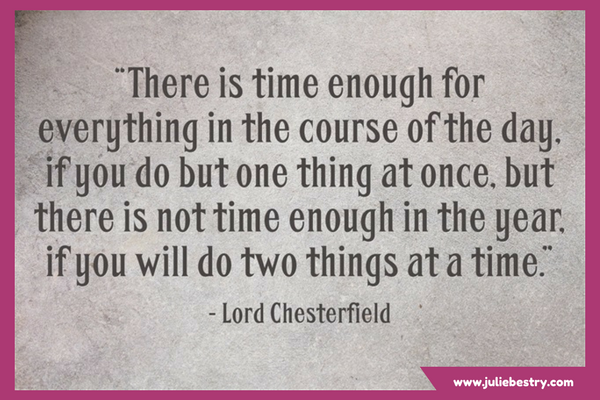
“There is time enough for everything in the course of the day, if you do but one thing at once, but there is not time enough in the year, if you will do two things at a time.”
~ Lord Chesterfield on multitasking
Philip Dormer Stanhope, the 4th Earl of Chesterfield, had lots of bright things to say about productivity:
I recommend you to take care of the minutes, for the hours will take care of themselves. (Good advice for productivity and task planning)
Choose your pleasures for yourself, and do not let them be imposed upon you. (A wise pronouncement regarding prioritizing, task planning, and joy!)
Know the true value of time; snatch, seize, and enjoy every moment of it. No idleness; no laziness; no procrastination; never put off till tomorrow what you can do today. (And to his thoughts on productivity and prioritization, Lord Chesterfield added still-revered advice on procrastination.)
The dude knew his stuff.
THE MYTH OF MULTITASKING
Do you perform data entry tasks while on conference calls or answer email while attending workshops? Worse, do you half-listen to your children or staffers or co-workers while flipping through papers? Do you text while you drive? Information and activity overload may lead you to embrace the idea of multitasking to improve efficiency. Don’t give in to the urge.
Multitasking not only fails to make you more productive; it increases all kinds of risks.
From the mid-1990s through the late 2000’s, studies published widely, from NeuroImage and the Journal of Experimental Psychology, and research at the University of Michigan, Carnegie Mellon’s Center for Cognitive Brain Imaging, and the University of California at Irvine all reported that multitasking wastes time and leads to distraction, errors, and memory lapses.
You may think you’re doing double-duty, but your brain is actually “task switching,” jumping back and forth between multiple attention orientations, doing each thing less efficiently and less effectively. Reply to a client email while listening to a teleclass, and you will miss salient details of both.
Giving up the myth of multitasking can be difficult. Intellectually, we may understand task switching, or know that checking social media is unproductive, or texting while driving is dangerous, but your senses try to convince you otherwise. It still feels like doing only one thing is wasting time. The longer you go on trying to do multiple things at once, the harder it will be to bring yourself to focus on anything, whether it’s client concerns, the document you’re writing, or the road ahead of you.
The longer you go on trying to do multiple things at once, the harder it will be to bring yourself to focus on anything. Share on XEmbrace the following tips to reduce your inclination toward multitasking:
1) Declutter Your Physical Space
Physical clutter overwhelms you even when you are not consciously aware of it. Neuroscientists at the Princeton University Neuroscience Institute found that disorder in your visual field limits your brain’s ability to process visual stimuli. If you can’t fully focus on just one thing, you’re creating your own attention deficit.
Start by eliminating anything from the “prime real estate” of your immediate work area that can’t help you with what you’re doing. File your papers away except for the folder of documents you’re working on right now. If you’re working on your computer, move your other digital devices to a counter behind you, or better yet, to another room.
2) Declutter Your Digital Workspace
Do you use multiple monitors with different content on each? Remember, the more you see, the less your brain can think about any one thing. Turn off your notifications, those CNN-like Breaking News tickers that tell you that someone has replied to your tweet or that there’s yet another political brouhaha. (The tweets and the news will all still be there when you’re done with your focused work.)
Clear your digital desktop so that instead of dozens (or hundreds) of individual files and documents on your screen, you’ve got a handful of categorized folders and sub-folders. (Or, if you’re less hierarchical and more trusting of search vs. hierarchy than Paper Doll, move everything to one searchable folder.)
Opt for a minimalist desktop. Instead of a busy photo of your last vacation, try a more calming desktop wallpaper from a site like Simple Desktops.
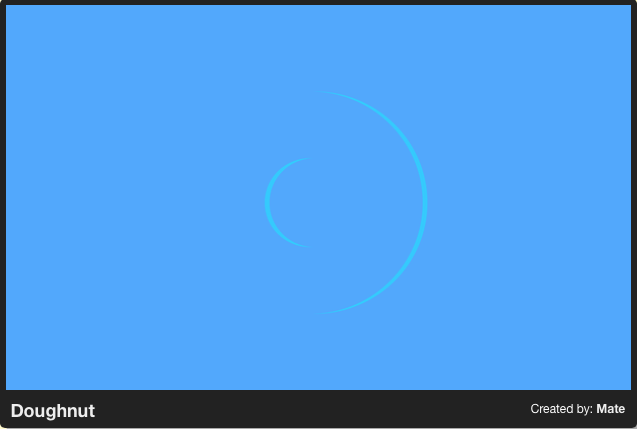
Gizmodo published an excellent field guide to Create a Minimalist Desktop to Be Proud Of. You don’t have to go to the ends of the minimalist desktop spectrum, as Joshua Fields Millburn of The Minimalists recently did with his desktop, but do make things easier on your eyes.
This is just a taste of what you can do to increase your digital focus. In future posts, we’ll be talking about ways to hide your browser tabs, blur the focus on any program except the one in which you’re working, and take whatever program you’re using to full-screen.
3) Shush the Distractions In Your Environment
Close your door. Post a sign telling your colleagues or family that you’re taking a page out of Cal Newport’s buzzy productivity book and that you’ll be doing Deep Work for the next 90 minutes. Leave them some pretty sticky notes and a nice Sharpie so they can plaster your door with messages.
Organize Your Days With a Little Color
We’re a week into the new year, and while some of you have your calendars or planners fully updated with all of your recurring appointments and items scheduled long ago, others of you have been trying to make do with that 13th month in your calendar while you decide what to do next. And perhaps, part of that search is how to make your days a little more colorful?
Paper Doll doesn’t doodle. I’m not visually artistic. I didn’t like coloring when I was little, and honestly, trying to figure out whether two colors go together, or making sure I’m coloring inside the lines, is stress-producing for me. But from the coloring tables at NAPO2016 to Smead’s SuperTab® Coloring Folders, I see many of you have embraced coloring, and you’ve got some support from research in the mental health and neurological communities:
Why Coloring Relieves Stress (And Is A Perfect Activity for Introverts)
10 Therapeutic Benefits of Coloring Books for Adults
Drawing, Art Therapy, And Stress Relief: What Research Says About Drawing Pictures for Stress Relief
The Science Behind Adult Coloring Books Explains Why They’re So Therapeutic
Given all of this, it stands to reason that it’s the coloring, not the book, per se, that is the key to stress relief, so it’s interesting to see how coloring being incorporated into other activities, such as the aforementioned Smead Coloring Folders, can improve the organizing experience.
Tasks, schedules, and appointments often make people stressed, so it’s no surprise that some enterprising calendar and planner designers would find a way to blend the precision of scheduling with the freedom and stress-reliving properties of adult coloring books. Today, we’re going to look at a few that might tickle your coloring fancy while helping you organize your days.
Franklin Covey Living Color Planner
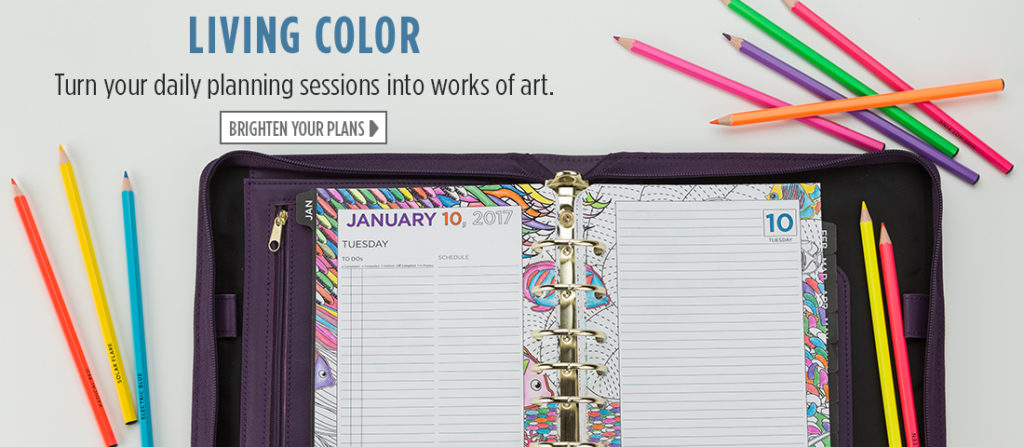
These ring-bound, two-page-a-day Franklin Covey pages come in Compact (4.25″ W x 6.75″ H x 0.5″ D) or Classic (5.50″ W x 8.50″ H x 0.5″ D), on 70# paper, with the monthly tabs included. They are available at Amazon in Classic and Compact for about $48 (for you Amazon Prime people) and directly from Franklin-Covey for about $44.
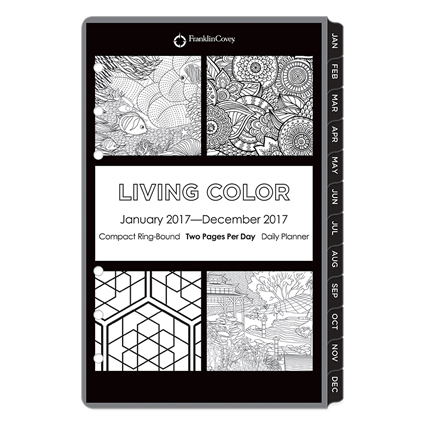
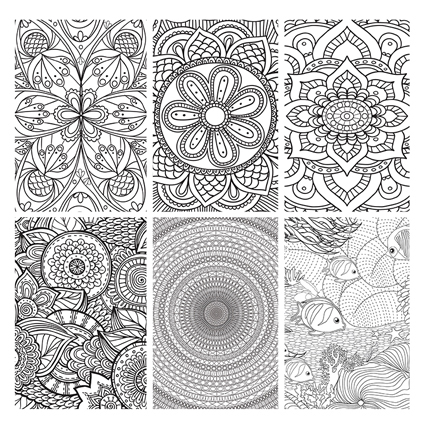 Of course, If you’ve already bought your ringed Franklin Planner for the year, don’t fret. Franklin-Covey has the coloring-loving early birds covered.
Of course, If you’ve already bought your ringed Franklin Planner for the year, don’t fret. Franklin-Covey has the coloring-loving early birds covered.
Franklin-Covey Coloring Page Packs
The coloring page packs, available directly from Franklin-Covey, come in two ring-bound sizes, Compact ($8) and Classic ($9), with a wide variety of black-and-white designs on the 32-sheet packs. The pages are printed on the same heavier, 70# paper as the Living Color Planner, but note that designs appear on only one side, while the reverse pages are blank.
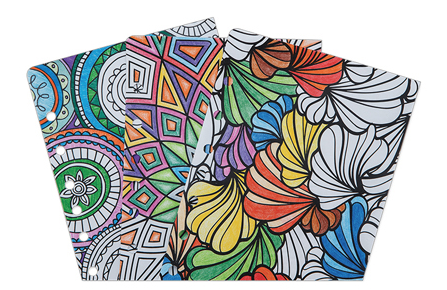
At-A-Glance FloraDoodle Premium Weekly/Monthly Planner
Mead’s At-A-Glance line includes a variety of delightful FloraDoodle-themed items, including pocket planners, wall and desk planners, and monthly/weekly planner in multiple sizes.
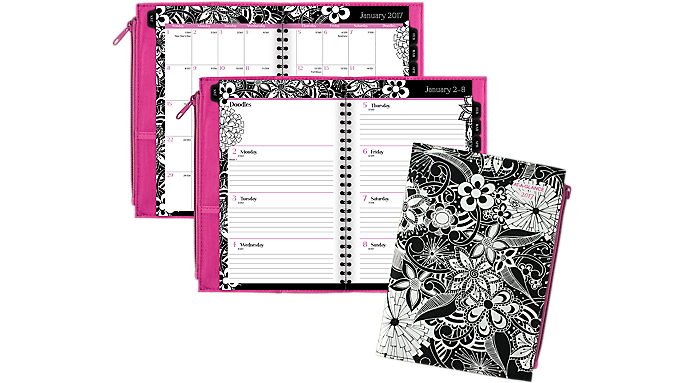
The wire-bound FloraDoodle planner has a flexible, pink, reusable (and removable) canvas cover with a zipper pocket for storage, and features a black and white design with a hand-drawn look. The individual page designs “feature white flowers on a black backdrop with a scribble look where flowers, petals, and squiggles lay overtop one another for a one of a kind pattern.”
Every page of the FloraDoodle planner displays black borders with a white flower pattern across the top for coloring. The two-page monthly pages are tabbed for easy navigation and include unruled daily blocks, as well as doodle space and past/future month reference calendars to manage upcoming events. The two-page per week weekly spreads provide an equal amount of ruled planning space for each day (Monday – Sunday) for recording daily tasks. Each weekly section begins with a blank space for doodling and drawing.
The FloraDoodle Weekly/Monthly Planner’s special pages include a holiday list, a three-year reference calendar, an overall event calendar, contact pages, note pages and planning pages for the following year.
Items from the FloraDoodle line are available directly from At-A-Glance, and at Staples, Shoplet, and other stationery vendors and at Target.com (but not in stores), and range from $7-29.
Color Drawing Schedule Academic Planners
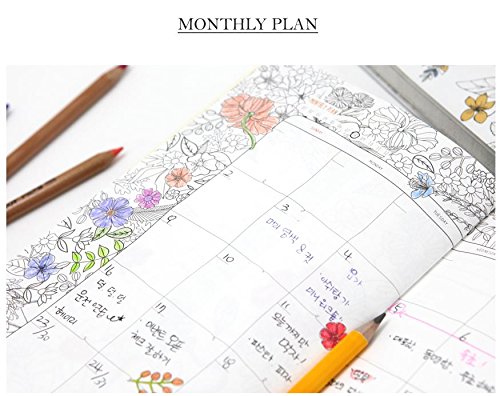
This academic planner is a little more loosey-goosey than the professional planners above, with un-dated pages so the user can begin at any point in time. Each coloring planner measures 5.1″ X 7.4″ and consist of monthly and weekly pages, accounting pages, a blank notes section and a checklist section for recording tasks.
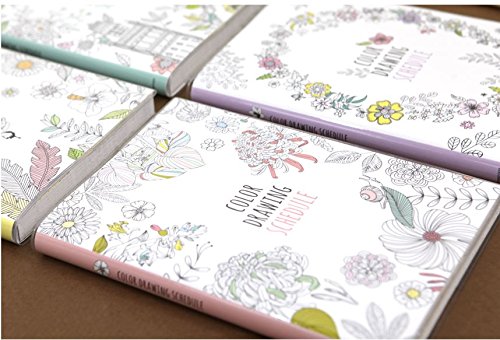
Each planner comes with a protective PVC cover to preserve durability, and two different coloring covers. (Note: While there are four different coloring cover versions, random coloring covers are shipped, so it is not possible to accurately predict and purchase a complete set.) Each planner runs under $10 at Amazon.
A related product in the same family is the Color Therapy Planner, sold at Cool Pencil Case for $12.50. The product description is almost identical except that specific “soothing colors” may be ordered: soft mint green, powder blue, rose pink, and mellow yellow.
For those looking for less of a robust planner set and more of a straightforward calendar or desk pad, you might like:
Fantastic Cities 2017 Wall Calendar by Steve McDonald ($7.50)
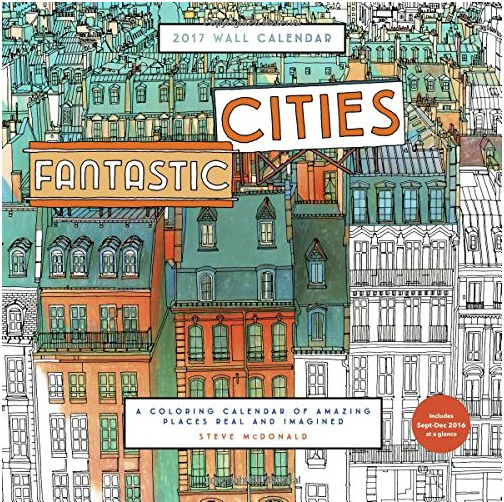
Blueline Botanica 2017 Mini Desk Pad Calendar ($6-$16)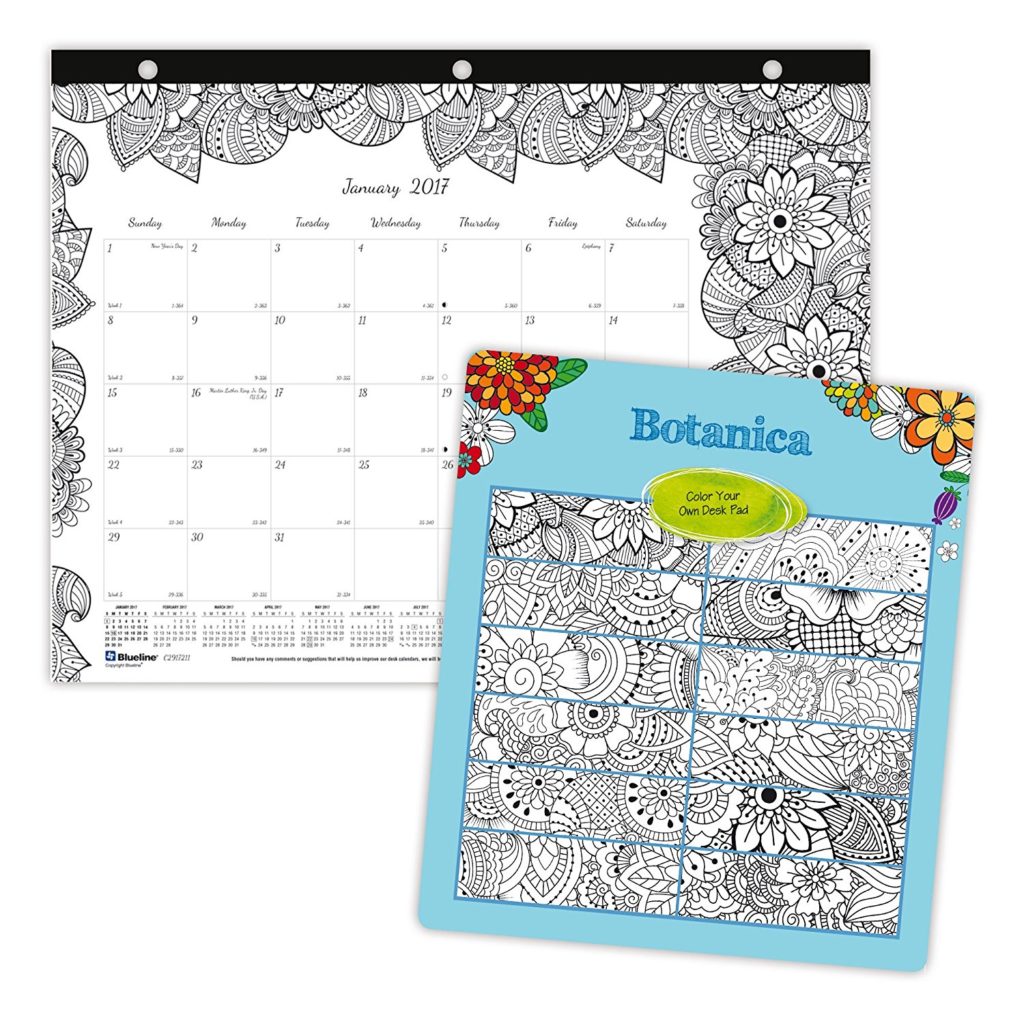
Joanna Basford Coloring Desk Calendar ($17)
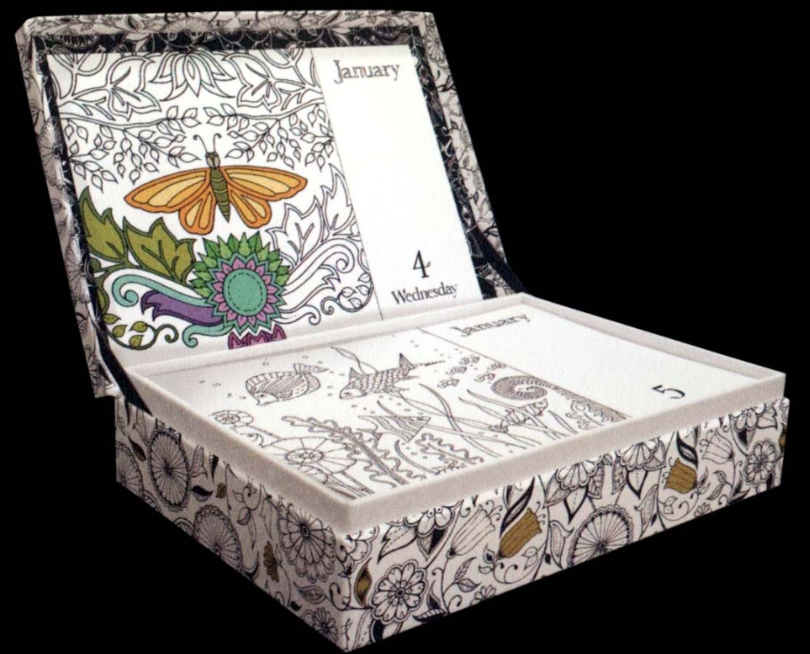 For fans of Johanna Basford, a superstar in the adult coloring realm, this 2017 calendar includes drawings from her Sea Garden, Enchanted Forest, and Lost Ocean coloring books, and comes with a keepsake box for storage. (Paper Doll‘s editorial note: Saved coloring pages easily become clutter, so do consider setting the box of colored pages free after the end of the year.)
For fans of Johanna Basford, a superstar in the adult coloring realm, this 2017 calendar includes drawings from her Sea Garden, Enchanted Forest, and Lost Ocean coloring books, and comes with a keepsake box for storage. (Paper Doll‘s editorial note: Saved coloring pages easily become clutter, so do consider setting the box of colored pages free after the end of the year.)
For more coloring calendars, check out Cleverpedia’s blog post, The Best Adult Coloring Calendars for 2017 for a gorgeous array of colorful planning options.
For more on how to pick the right calendar or planner for your needs, you might like to review Pick Your Planner 2015: Paper Doll Rounds Up the (Un)Usual Suspects.
Whatever calendars you use, whether paper or digital, Paper Doll believes that commitment to your system is the key to success. If coloring your appointment pages helps you keep your commitment, then, by all means, make your days colorful!
Paper Doll Organizes Boxing Day Downton Abbey-style with Give Back Box®
You’ve got boxes, right? After a weekend of giving and receiving gifts, you’re likely surrounded by boxes. Everywhere you turn, boxes. It’s practically a Day of Boxing! Well, actually…
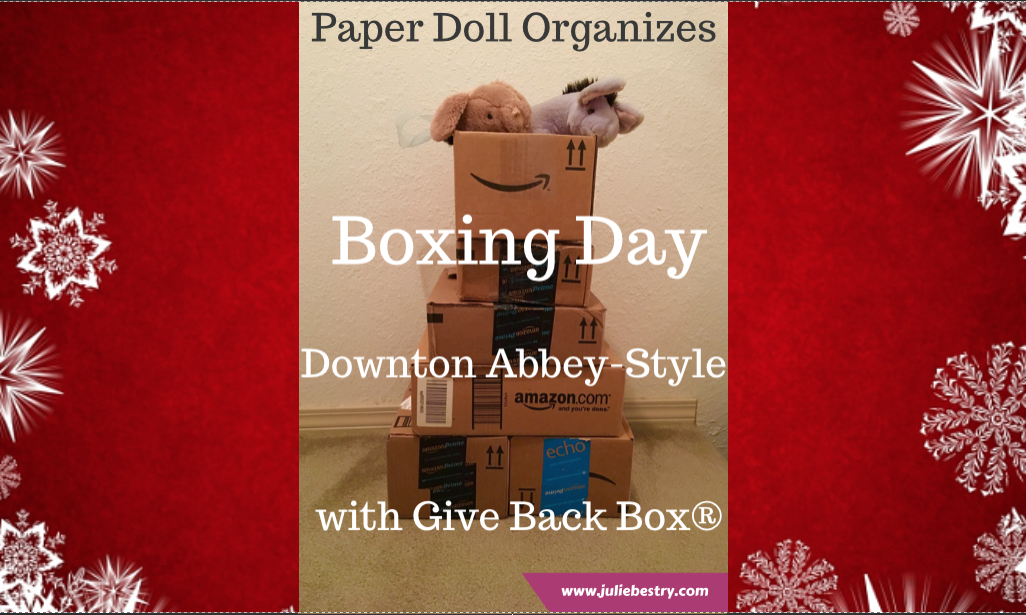
Boxing Day, observed on December 26th, the day after Christmas (and this year, the second day of Hanukkah), is a holiday popularly celebrated in the UK and various Commonwealth nations, many of which used to be British colonies. The history of the holiday is complex and widely debated, but traditionally, servants and tradespeople were given Christmas boxes on the day after Christmas, when they were granted leave to visit their own families and did not have to work. How very Downton Abbey of them.
Before you move along to another post, affecting a posh accent and saying, “I’m going upstairs to take off my hat,” I’d like to suggest a much more rewarding way to observe Boxing Day.
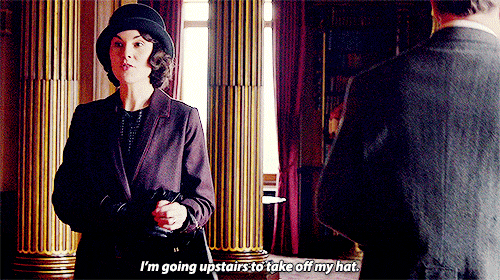
Give Back Box®, through a partnership with Amazon, Overstock.com, Ann Taylor, REI Co-Op, and more than a dozen other retailers, has found a solution that allows you to encourage yourself to pare down your excess possessions, bless others with donations of your largesse, and get those cardboard shipping boxes out of your house, all in one fell swoop.
![]()
THE MISSION STATEMENT
The purpose of Give Back Box® is to provide an effortless and convenient method of donating your used household items. Give Back Box not only provides an easy way to be part of a truly good cause, it also allows cardboard boxes a second life by recycling them and keeping them away from landfills to help improve our environment. So this is an all-round CSR & Sustainability solution that costs you literally nothing.
THE PROCESS
- Take your Amazon (or any other retail partner’s box), and empty out the goodies you’ve received. (You can also use a plain cardboard box, if you like.)
- Fill the box with donations of clothing, shoes, and various household goods. But please, no liquids, electronics, ammunition, or fragile or hazardous things! (And do check the pockets for any train tickets that might prove you innocent of murder.) Then seal up the package.
- Print a free pre-paid shipping label from Give Back Box’s site and affix it to the box. The cost is covered by Give Back Box’s partner retailers, most of whom have special Give Back Box pages on their sites, too.
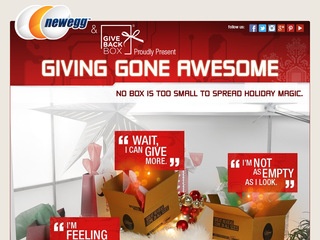 There’s no weight limit, so you can fill the box to the brim — and print as many labels as you need.
There’s no weight limit, so you can fill the box to the brim — and print as many labels as you need.
- Now, just send the package to Goodwill via UPS or the United States Postal Service at any UPS Store or post office, all at no cost to you. You can even request a free USPS pick-up of your package at your home, if the weather outside is not so delightful and you’d rather lounge about and have your lady’s maid, Anna, serve your meals in bed.
THE BENEFITS
Give Back Box box has a variety of benefits — personal, social, economic, and environmental.
You’ll make donations more often — You know you’re busy. You know your house is full of things you don’t use, don’t wear, or don’t want. (Honestly, what was Aunt Rosamund thinking?) You want to donate more things and more often, but the truth is that every time you find something in your home that you want to donate, you set it aside and forget about it. Maybe you have a donation station in your home, with the pile getting bigger and bigger, but it practically takes an act of Congress to get the donations out of your house, into your car, and to whatever non-profit you choose.
By making it free and convenient, Give Back Box prompts you to think about what you can let go of every single time you receive a box from one of their partner retailers.
Boom! There’s your habit! Get a box of stuff? Give a box of stuff!
That’s good for you, and it’s good for all the work that Goodwill does, providing job training and putting people to work in the local community. And people who want and need what you no longer have space or time to manage reap the benefits, too!
It’s also sustainable. About 30 million tons of retailers’ cardboard box material is zooming around the earth each year. By following the principles of “reduce, reuse, and recycle,” Give Back Box and its partners are helping you clean out your house and helping us all clean up the environment.
Even the Dowager Countess would be excited!
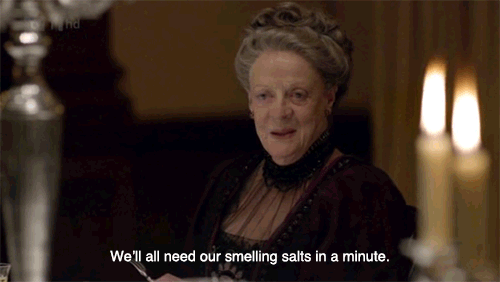
Still have questions? Read through the Give Back Box page of frequently asked questions, and check out this little video.
Paper Doll & Smead Continue the Debate: Paper vs. Digital for Calendars & Task Lists
Last week, in Paper Doll & Smead Talk Paper vs. Digital Organizing: It’s Not Either/Or, you got to see the first part of my discussion with John Hunt of Smead about the anxieties many people face when thinking about moving their information from paper to digital. We discussed control vs. convenience, and how the learning curve with technology can be an obstacle to exploring solutions.
We also reviewed the scientific research on learning and cognition related to taking notes by hand vs. on the computer, and even explored the relative merits and drawbacks for reading paper books vs. using digital devices. We even talked about how marketing messages on paper vs. digital can have differing persuasive powers.
I made the case that there were different situations and individuals for which paper might be the right choice, and others where a digital solution could be better. And there were definitely indications that a hybrid system might be best.
Today, in a continuation of that Keeping You Organized podcast discussion, we continue that chat and explore two of the productivity tools that engender the most debate on the paper vs. digital landscape: calendars and task lists.
Calendars — We discuss the relative advantages and disadvantages of paper vs. digital calendars, and delve into portability, syncing, visualization, creativity vs. linearity, and personalization. We also got into how comprehension of the passage of time (whether via analog or digital clocks, or using paper vs. digital calendars) can impact how we live our lives.
To Do and Task Lists — With a plethora of to do and task apps out there, some people are overwhelmed by the depth and breadth of options and choose the analog paper list every time, while others live and die by the task app. John and I talk about my hybrid approach to task tracking, and why using your calendar as a task or to do list is really fraught. And because productivity is all about priorities, we had to talk about the role prioritization plays in getting things done, whether you’re jotting those priorities on a sticky note or accessing them from the cloud.
Jump right in:
Remember, you can also watch (or download the audio only, if you prefer an auditory podcast experience) right at Smead’s page for Part 2 of our chat.
And, if you like what you hear, be sure to check out the other discussions John and I have had about organizing, and listen to what my great colleagues in professional organizing and productivity have had to say. Just pop over to the stellar Keeping You Organized podcast archive page.
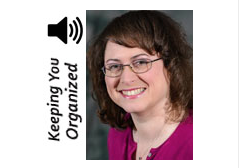
Podcast 041: Secrets to Organizing a Small Business
Podcast 108: Fears that Keep You from Getting Organized
Podcast 153: Paper vs. Digital Organizing: Part I
Finally, once you’ve listened to parts 1 and 2 of our Paper vs. Digital podcast discussions, share your thoughts in the comments sections of either or both posts. What are your thoughts and preferences:
- Do you have app overload, or do you enjoy exploring tech solutions for organizing?
- Ebooks or dead trees — how do you like to read?
- Notetaking — would you rather grab a pen and pad, or put your notes into something like Evernote? Does it differ whether you’re taking notes for academic work vs. meetings?
- Paper planners or digital calendars: where do your appointments live?
- Task lists: sticky note/paper pad or task app?
Paper Doll & Smead Talk Paper vs. Digital Organizing: It’s Not Either/Or
Recently, I sat down again with John Hunt for Smead‘s excellent video podcast series, Keeping You Organized. We wanted to get to the heart of that question, “Which is better, paper or digital organizing?” But as we got into it, I was able to explain my view, that it’s really a false dichotomy.
There are so many things we have to organize — our academic notes and research, our to do lists, our appointments, our thoughts — in order to keep our heads afloat. Even the fun things in our lives, like the books we read, can be overwhelming if we don’t have a way to organize the collections so we can enjoy and remember what we’ve read. And would you believe certain marketing messages — which impact our pocketbooks and those little green pieces of paper — can have a greater or lesser effect depending on whether they come on the page or the screen?
Sometimes, the decision over whether to go paper vs. digital is aesthetic — we like the feel of paper, or the glossy nature of a screen. But I’ve found that emotions play the largest role in how we choose a platform.
The problem we professional organizers often see is that people have anxiety around this whole issue of paper vs. digital. Some people feel anxious about not moving their whole lives to the cloud — digital task lists, calendars, ebooks, phone books — they’re afraid they will seem out of touch if they don’t eschew paper and embrace everything digital. Meanwhile, just as there is a backlash against modernity with hipsters and music purists preferring vinyl, there are those who will only relinquish their Moleskines when you pry them from their cold, dead hands. But it doesn’t have to be like this!
In my discussion with John, we talk about all the different situations, and the different types of learning styles and personality types, for which organizing by paper, or digitally, or through a combination of the two, might work best.
Take a look:
If you visit the source, you can watch us right at Smead’s Keeping You Organized podcast page or download the show as an audio podcast to listen while walk or work. While you’re there, peruse other episodes in the multi-year series, including some with me, your Paper Doll:

Podcast 041: Secrets to Organizing a Small Business
Podcast 108: Fears that Keep You from Getting Organized
Finally, John and I had SO MUCH to discuss (because when does Paper Doll ever run out of words?) that there’s a second whole video podcast on the way, where we continue the conversation. How’s that for organizing a holiday gift for you readers and viewers?

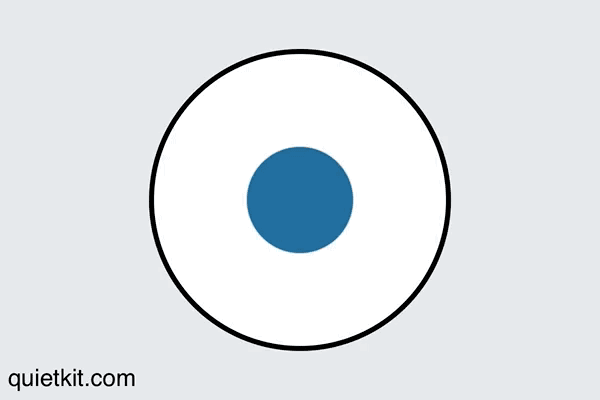 When feeling overwhelmed, simply:
When feeling overwhelmed, simply:
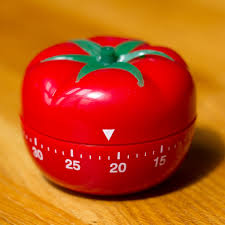
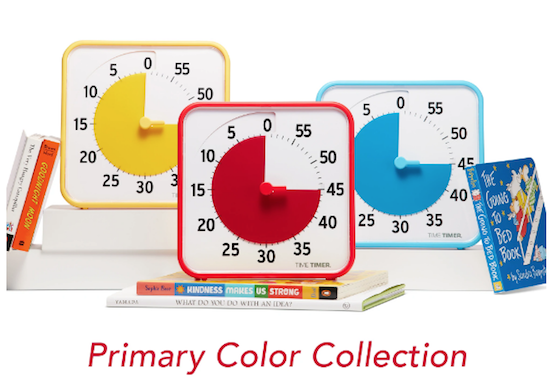




Follow Me